Scott Pilgrim vs. The World: The Game is a retro beat ‘em up based on the Scott Pilgrim graphic novel and released as a tie-in to the 2010 film adaptation. It tells the story of a boy named Scott Pilgrim who meets a girl named Ramona Flowers at a party. Scott is instantly infatuated but learns that to date Ramona he must first defeat her seven evil exes, who have formed a nefarious League to prevent anyone else from loving her. I choose to play as Scott, Ramona, or one of their friends and battle across a fantastic version of Toronto, ensuring Scott and Ramona can get together.
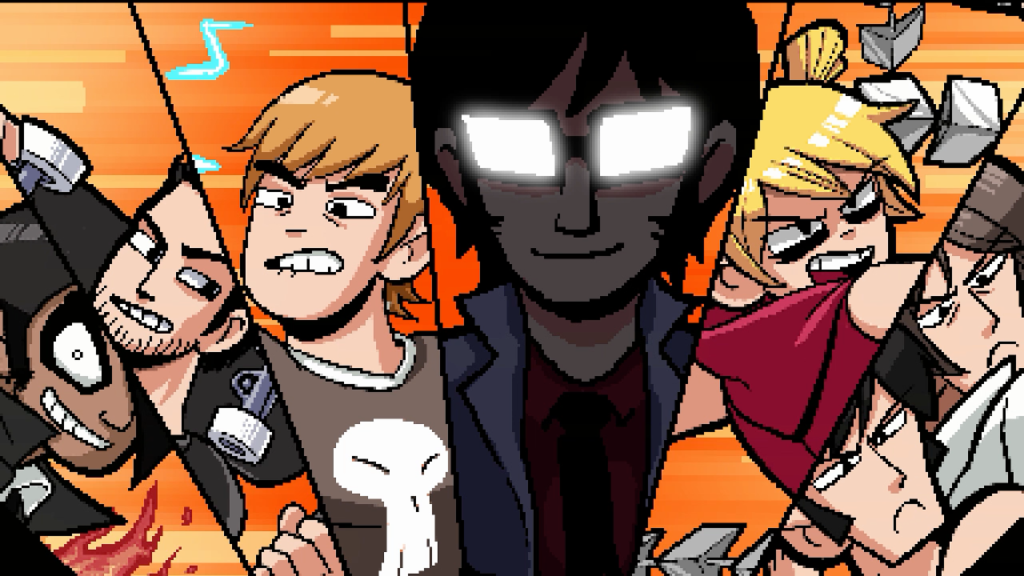
Like its source material, Scott Pilgrim: The Game draws its influences from millennial culture, creating a world where disaffected youth understand and interact with the world like it is a videogame. It’s a world where Scott has a monochromatic evil twin named Nega Scott, where a vegan diet gives a person super powers, and where commuter trains trundle on to their destinations even as they are sliced into pieces by jealous ninjas. This gives it a meta quality; it’s a videogame about a world that evokes videogames. While Scott Pilgrim: The Game references dozens of videogames, its primary inspiration is the NES beat ‘em up River City Ransom. Its dedication to this inspiration is its biggest weakness.
After selecting a character from a Super Mario Bros. 2-inspired select screen and then a level from a Super Mario Bros. 3-inspired map screen, my player character is dropped into the familiar beat ‘em up environment. It is my job to move them from one side of the level to the other, avoiding obstacles like pits, hibachi ovens, and buses while defeating the mooks who try to stop me. Every character starts with the same basic moveset: a fast attack, a strong attack, a block, and a jump. I use these abilities to brawl across Toronto’s streets, defeating dozens of other twenty-somethings who are set on stopping the gang from reaching the next evil ex.
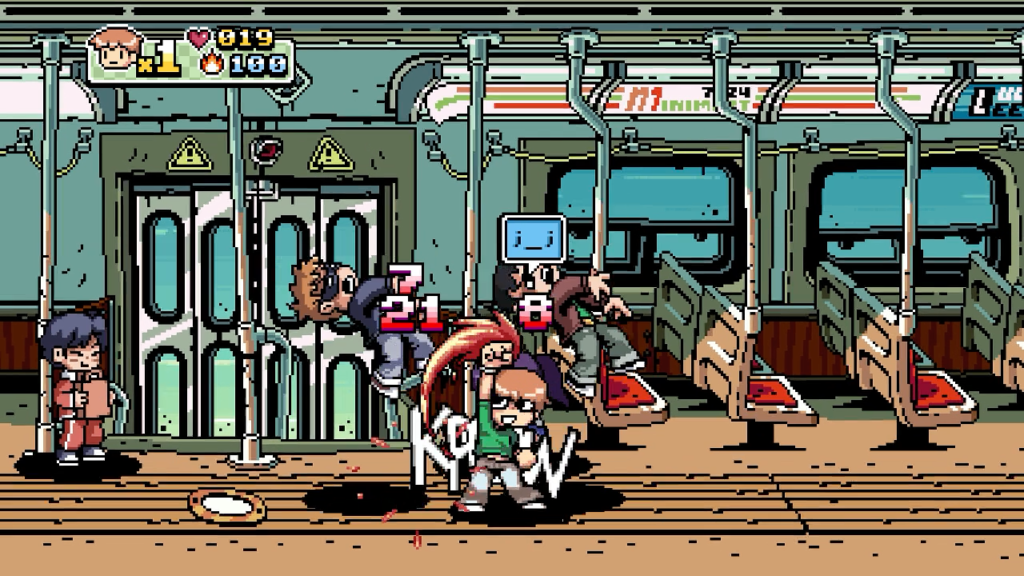
Part of the humor is in how inexplicable all this fighting is. Other beat ‘em ups have some excuse to explain the army between the protagonists and their destination—usually they’re thugs in a nebulous street gang—but Scott Pilgrim: The Game doesn’t even try to justify itself. Random hooligans, robots, and actors in literal fire-breathing dragon costumes have to be punched and kicked out of the way because that’s how beat ‘em ups work. It’s an irreverence that typifies Scott Pilgrim’s humor.
One feature that sets Scott Pilgrim: The Game apart from other beat ‘em ups is Guts. Guts serve as a resource for a variety of combat mechanics. Primarily, if my player character runs out of hit points then some will be restored with a converted portion taken from their Guts. They only lose a stocked life if their Guts meter is empty, whereupon they revive with restored hit points and Guts. I can also use Guts to unleash flashy super attacks, to summon Knives Chau who provides unique assistance to each character, or (in coop multiplayer) to perform a screen-clearing performance from Sex Bob-omb, Scott’s band. Any of these abilities can change the course of a single battle, but leaves fewer Guts to recover with. Other beat ‘em ups often have super abilities which drain actual hit points to use, which rarely feels prudent, so it’s a smart compromise to drain potential hit points instead. The result is still the same: I choose to save all my Guts for revives and never feel like I’m missing anything by not using the super attacks.
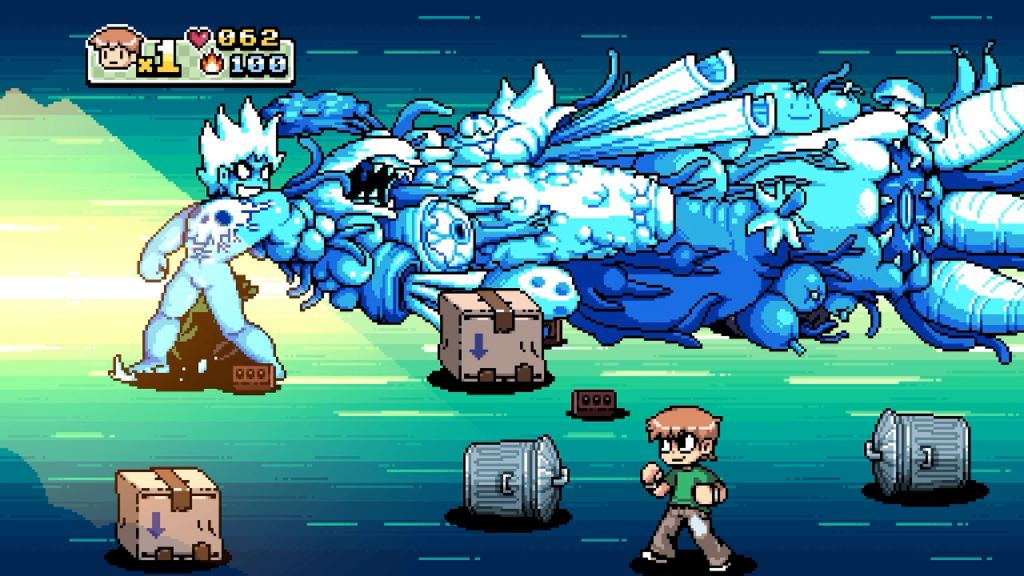
When I reach the end of a level my player character battles one of Ramona’s seven evil exes. These battles show Scott Pilgrim: The Game’s design at its most intricate and its visuals at their most imaginative. I battle Lucas Lee on a movie set where he’s a straightforward opponent—until he gets his hands on a skateboard and becomes a lightning-fast piledriver. Todd Ingram’s vegan superpowers make him nigh-invulnerable so I must dodge his attacks until he exhausts himself. I first confront the Katayanagi Twins on a rooftop where I must destroy their giant mecha that bombards me with rockets and swinging fists before pursuing them to their club for a final showdown. Each duel with an evil ex is filled with charm and no two are quite the same.
I would like to say that Scott Pilgrim: The Game is a fun beat ‘em up take on an irreverent pop culture property. I would like to say it, but fun is impeded because starting out sucks.
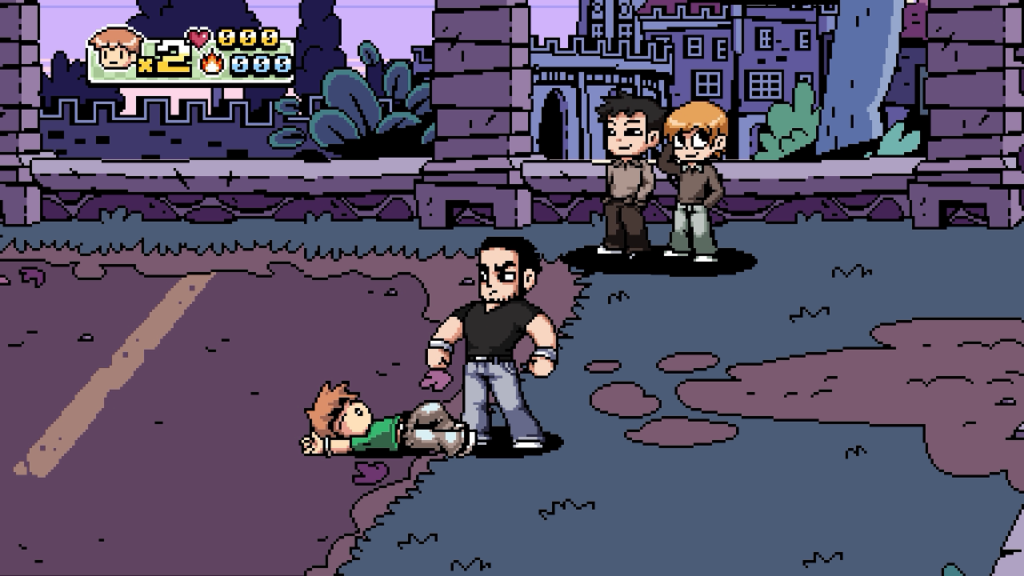
Combat is governed by RPG character stats: Strength, which increases damage dealt; Defence, which decreases damage taken and increases total hit points; Speed, which increases how quickly a character moves; and Willpower, which increases total Guts points and the power of Special attacks. When I first play as a character they have zeroes in all these categories. With a strength stat of zero, Scott deals about two damage per hit. This is manageable at the outset but still inflates its length—the first level takes me over twenty-five minutes to finish with a fresh character, an absurd length for a beat ‘em up. Things are more untenable in the second level, and by the third I am simply outmatched. To catch up with increasing enemy strength I must increase my player character’s stats with purchasable items.
Every enemy turns into a pile of coins when they are defeated which I can exchange in shops for items. Shops are located across Toronto, but most of them are located in the Shopping District in the first level. Nothing indicates I am able to enter these shops, and on my first visit I walk right past them, dismissing them as cheerfully lit background decorations. Eventually I realize my mistake and return there to buy much-needed item upgrades.
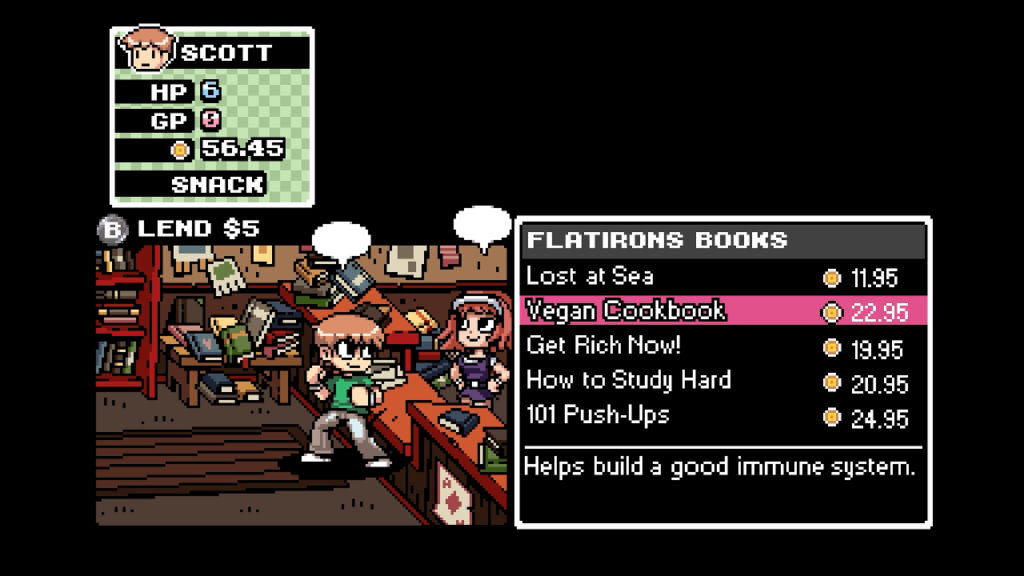
Shops sell three different item types. Some restore hit points upon purchase, some I carry with me to restore my hit points if I die as a pseudo-one up, and some items increase stats. The only way to find out what effect an item has is to buy it. I determine that Scott’s weak damage is holding me back most so I visit a half-dozen shops looking to increase his strength stat. But what do I buy? The avocado hasamaki, $2.50 at the Sushi Bar? Maybe Crash and the Boys for $14.95 at Shock Wave Records? A burrito grande sold at Dee’s Tex Mex for $11.25? I immediately feel like I’m wasting what little money I have trying to find the item I need and receiving only a negligible improvement in a random stat once I do.
Finally I resort to looking at a guide to decide what I need to buy, zeroing in on the Bionic Arm sold in Wallace Well’s hidden shop which sells for a whopping $129.95. I have to replay the first and second level several times to afford it but the effect on enemies in the third level is immediate and I am able to clear it.
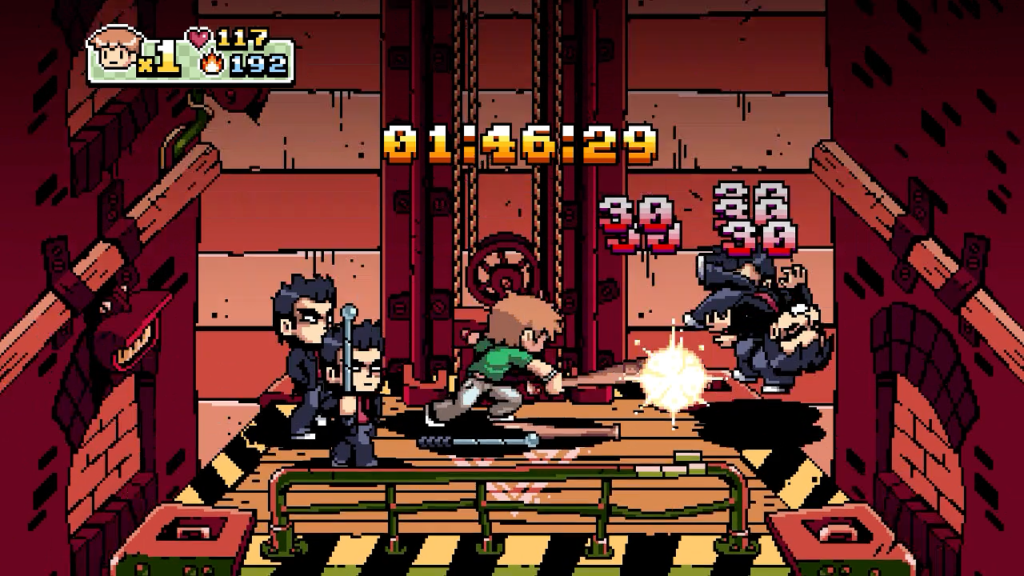
It takes three or four hours to max out a character’s stats and this is when Scott Pilgrim: The Game’s difficulty feels in line with other modern beat ‘em ups. But only for that one character. If I want to play as another, I have to grind their stats for three to four hours before they become enjoyable—maybe even tolerable—to play too.
I am left to ask why. Why do I have to grind to make Scott Pilgrim: The Game a manageable difficulty? Characters also gain levels as they defeat enemies, learning new abilities as they rank up. Why do I also have to grind a character to level sixteen before they learn all their abilities? Why is a Jump Kick, a standard beat ‘em up ability, buried behind several hours of grinding with Scott? Why is there a four hour grind to bring Scott, Ramona, or one of their friends up to the snuff most other beat ‘em up player characters begin their story with?
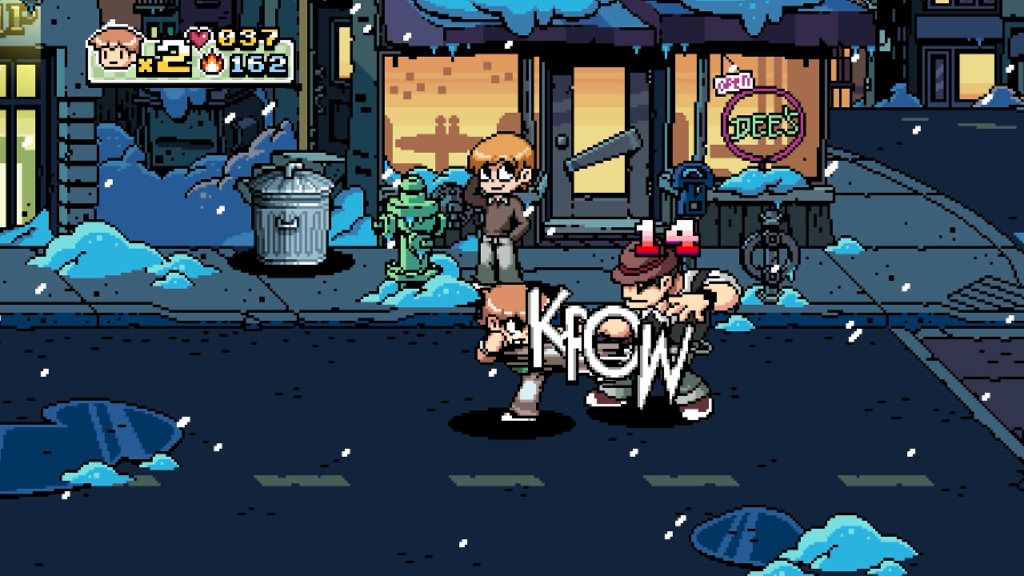
My only explanation for this is how heavily Scott Pilgrim: The Game is inspired by River City Ransom, a quirky and influential but frankly flawed NES beat ‘em up that also incorporates RPG elements into its design. Many retro titles borrow design ideas from early genre classics but update them to clarify their opaque elements. Scott Pilgrim: The Game takes River City Ransom but forgets to update it, and my entire experience suffers for it.
Scott Pilgrim: The Game is aimed at fans, which is probably why I don’t enjoy it as much as I feel I should. I have not read the graphic novel, so most of the references to it are going over my head. I have seen the movie and have mixed feelings about it. It has a fun tone and moves at an exhilarating speed but Scott is an awful person and I never find myself rooting for him. After seeing the way he treats Kim Pine and Knives Chau, a relationship with Ramona never feels like something he deserves. And Ramona herself is rendered into a passive observer of her own fate in the climax.
The premise in all three adaptations also raises questions: Why is Ramona a prize to be won after defeating her seven evil exes? Isn’t her life and agency being impeded by these past relationships where she is treated as an object to be guarded and coveted? Why in a world where superpowered villains exist and are dealt with through videogame logic-infused battles is her solution to their abuse to move to Toronto? The graphic novel might address these issues but the film can’t be bothered.
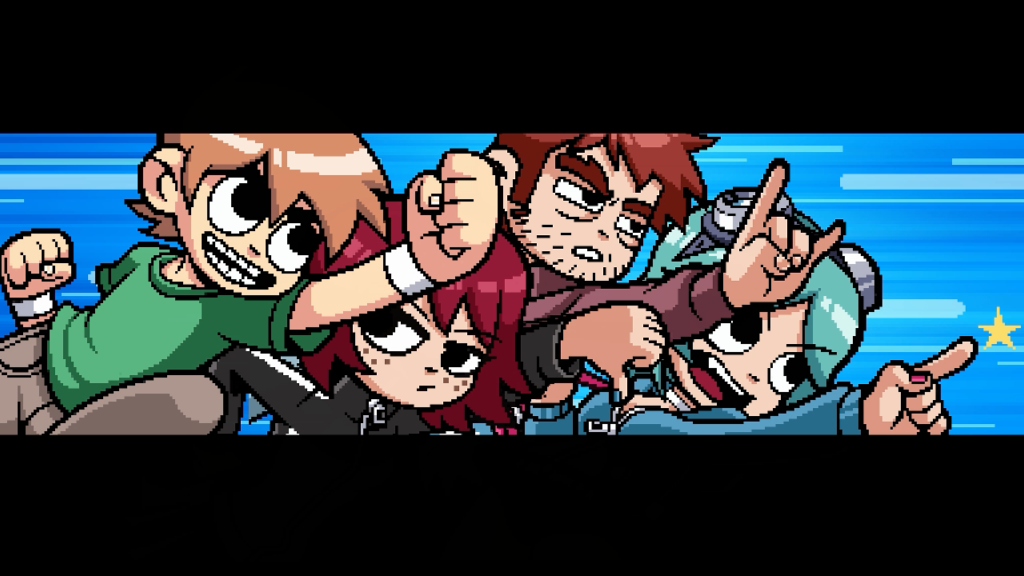
Scott Pilgrim: The Game at least lets me play as Ramona so she can challenge her exes herself. At least here it feels like she is making decisions in a story that has greater stakes for her than for Scott. As a beat ‘em up, a genre more concerned with punching and kicking things than with asking questions, this is the best it can do. Maybe for just this one videogame it’s enough for Ramona to punch and kick her way to a conclusion she actually wants for herself. It’s just a shame I have to grind so much to help her do it.